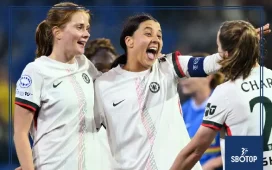The Carabao Cup rarely fails to produce excitement, and the opening round of the 2025 edition proved to be no exception. Packed with goals, drama, and moments that will be remembered for months, the first hurdle in England’s second most prestigious domestic cup competition delivered everything from a wonder strike that stunned the crowd to three nail-biting penalty shoot-outs that left players and fans alike on edge.
This article provides a comprehensive dive into round one: the matches that stood out, the players who stole the spotlight, the tactical stories that unfolded, and what it all means for the clubs as they continue their campaigns. With 19 goals scored across the ties, the stage was set for a competition that continues to remind the football world why cup football is so special.
The Carabao Cup A Brief Context
Before diving into the drama of round one, it’s important to reflect on the competition itself. The Carabao Cup, officially the EFL Cup, has long held a unique place in English football. Unlike the FA Cup, it is exclusively contested by the 92 clubs across the Premier League and the English Football League. For lower-tier sides, it represents a chance to test themselves against top-flight opposition and earn invaluable revenue. For bigger clubs, it provides an opportunity to blood young talent, rotate squads, and, in some cases, secure an early path to silverware.
Over the years, the Carabao Cup has produced unforgettable moments: from Wigan Athletic’s giant-killing runs to Manchester City’s relentless dominance under Pep Guardiola. The first round, however, often flies under the radar. Yet, this year, it refused to be ignored.
19 Goals A Feast of Attacking Football
Round one was defined by goals. Across multiple fixtures, defenses looked vulnerable, strikers were clinical, and chances flowed. Cup competitions often force managers into rotating their squads, and the relative unfamiliarity between defenders can lead to open, unpredictable matches. That was exactly the case here. Among the standouts was a clash between two mid-table Championship sides that produced a thrilling 4–3 scoreline. End-to-end football, aggressive pressing, and defensive lapses gave fans the kind of spectacle they dream of on a Tuesday night. Another tie ended 3–2 after a frantic comeback from a side that looked dead and buried at half-time, epitomizing the “never say die” attitude cup football inspires.
In total, 19 goals were recorded across the round, averaging over two per match. That figure not only underscores the offensive spectacle but also suggests a pattern: managers, perhaps unwilling to risk extra-time or penalties, encouraged their sides to play on the front foot.
The Wonder Strike That Stole the Show
If the round is remembered for one individual moment, it will undoubtedly be the wonder strike that lit up the night. Midway through the second half of a tense tie, a midfielder—often more renowned for his industry than his flair—produced a goal of extraordinary quality.
Receiving the ball 30 yards from goal, he turned past one marker before unleashing a thunderous effort that arrowed into the top corner. The goalkeeper, despite a full-stretch dive, had no chance. The crowd erupted, teammates swarmed him, and within seconds, social media was awash with clips of the strike.
In the modern game, where analysis dominates the narrative, moments of pure spontaneity remain priceless. This strike was more than a goal; it was a reminder of football’s raw beauty. For the player himself, it could be a career-defining highlight.
Three Shoot-Outs High-Stakes Drama
Penalty shoot-outs are where the Carabao Cup often shines brightest, and round one did not disappoint. Three ties went the distance after neither side could be separated in regulation time.
- Shoot-Out One: The Giant-Killer’s Triumph
A League Two side faced Championship opposition and, after a gritty 1–1 draw, held their nerve from the spot. Their goalkeeper became the hero, saving two penalties before calmly converting his own in sudden death. It was a victory that sent their fans into delirium and reaffirmed the magic of the cup. - Shoot-Out Two: The Youth Academy Showcase
In another tie, a Premier League academy graduate, making his senior debut, stepped up to take the decisive penalty. Showing composure beyond his years, he slotted the ball home with authority. That moment may prove to be a launching pad for his professional career. - Shoot-Out Three: The Heartbreak Story
For one club, heartbreak arrived in the cruelest fashion. Having led the shoot-out 3–1, they squandered two chances to seal the game, only to watch their opponents claw back and eventually clinch the win. For their fans, it was a bitter pill to swallow, but such is the drama of penalties: ecstasy and agony in equal measure.
Tactical Trends in Round One
Beyond the raw numbers, tactical narratives also shaped round one. Several managers used the opportunity to experiment, deploying unfamiliar formations or giving fringe players extended minutes. A few patterns emerged:
- High Pressing by Lower-League Sides:
Determined not to simply sit back, several League One and League Two clubs pressed aggressively, attempting to disrupt the rhythm of technically superior opponents. While this occasionally backfired, it also forced mistakes and led to goals. - Reliance on Wing Play:
Cup matches often see wing play emphasized, with wide players given the freedom to attack full-backs. A number of goals came from whipped crosses or cut-backs, underlining the importance of stretching defenses. - Defensive Rotations and Mistakes:
With first-choice defenders often rested, makeshift backlines were vulnerable. Miscommunication led to soft goals, but it also heightened the sense of unpredictability that defines the Carabao Cup.
Players Who Made Headlines
Every round of the Carabao Cup produces new heroes, and this edition was no exception. A few players stood out:
- The Hat-Trick Hero: A striker from a mid-table Championship side netted three times, showing clinical finishing and making a case for a regular starting role.
- The Young Playmaker: A 19-year-old midfielder orchestrated attacks with vision and confidence, earning plaudits from pundits who see him as a star in the making.
- The Goalkeeping Giant: In one of the shoot-outs, a veteran goalkeeper proved decisive, not only with saves but also with his psychological tactics to unsettle opponents.
Fans and the Atmosphere
Cup ties are as much about the atmosphere as the football. The first round witnessed sold-out smaller stadiums, with fans packing terraces to witness potential upsets. The energy was palpable: chants echoed long after the final whistle, and pitch invasions in celebration highlighted the passion the Carabao Cup continues to evoke.
For many lower-league supporters, these ties provide rare chances to see their side tested against higher opposition. For larger clubs’ fans, it’s a glimpse of future stars. Together, these ingredients create a unique atmosphere that distinguishes the Carabao Cup from league fixtures.
The Broader Significance
While some dismiss the early rounds of the Carabao Cup as secondary to league campaigns, their significance cannot be underestimated. For managers under pressure, progress provides breathing room. For players on the fringes, standout performances can transform careers. For clubs outside the top flight, victories bring financial boosts and prestige.
Historically, cup runs have even acted as springboards for league form. A side gaining momentum in August often carries that confidence into their domestic season. Conversely, early exits sometimes foreshadow troubled campaigns.
Also Read:
- SBOTOP: Man City’s 115 Charges Under Scrutiny as Premier League Admits No Control Over Case Timeline
- SBOTOP: Steven Naismith Appointed Scotland Assistant as Leicester’s Andrew Hughes Takes on Set-Piece Coach Role
- SBOTOP: Dominic Calvert-Lewin Set for Fresh Start as Ex-Everton Striker Reaches Agreement to Join Leeds on Free Transfer








